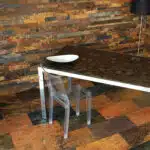Tiling a house can be a daunting task for those who have little to no experience in DIY projects. However, with the right tips and troubleshooting techniques, it is possible to achieve a professional-looking finish without breaking the bank. Tiling is an art that requires precision, patience, and attention to detail. In this article, we will explore some essential tips and tricks that will help you tile your house like a pro.
Before embarking on any tiling project, it is crucial to plan and prepare adequately. The first step is to make sure that you have all the necessary tools and materials before starting. This includes measuring tapes, tile cutters, adhesive, grout, spacers, and sealant. It’s also essential to consider the layout of the tiles and how they will fit together in each room. Attention should be paid to areas such as corners and edges where cuts may need to be made. By following these tips and taking care during the installation process, you can avoid common mistakes that could lead to costly repairs down the line.
Planning And Preparation
Proper planning and preparation are vital when tiling a house yourself. The first step in this process is to create a budget. Determine the amount of money you have available for the project and allocate it accordingly. Consider expenses such as purchasing tiles, tools, adhesives, and grout, as well as any additional costs for unexpected repairs or modifications.
Once you have determined your budget, it’s time to gather the necessary equipment. Essential tools include a tile cutter, notched trowel, spacers, level, measuring tape, and safety gear such as gloves and eye protection. You may also require a wet saw or angle grinder for cutting tiles with intricate shapes or curves.
Before beginning your tiling project, ensure that your work area is clean and free from debris. Remove any old tiles or flooring materials to create a smooth surface. Additionally, inspect the walls or floors for any cracks or uneven surfaces that may require repair before tiling. Taking these steps will help ensure that your tiling project runs smoothly from start to finish. In order to proceed with measuring and cutting tiles accurately, it’s important to verify that the surface being tiled is flat and even throughout.
Measuring And Cutting Tiles
- Accurately measuring tiles is an essential first step to ensure a successful tiling job; tile measurements should take into account any walls, edges, and corners.
- Cutting tiles can be difficult and time-consuming, but is a necessary task; it is important to use the right tools and techniques to ensure that the tiles fit together properly.
- Careful consideration should be made when deciding how to cut tiles; factors such as the size and shape of the tiles, as well as the layout of the tiling area, can affect the approach taken.
- Troubleshooting common problems when cutting tiles can help save time and money; steps can be taken to reduce the chance of mistakes occurring, such as double-checking measurements and using the correct cutting tools.
Measuring Tiles
Measuring tiles is a crucial step to ensure that your tiling project will be a success. A common mistake that most beginners make is not measuring the space properly, leading to uneven or misaligned tiles. To avoid this, you must have the right tile measurement tools on hand.
One of the essential tools for measuring tiles is a tape measure. This tool will help you accurately measure the length and width of the area where you plan to install the tiles. Another useful tool is a laser level, which can help you maintain a straight line when laying out your tiles. Additionally, having an angle finder will come in handy when installing tiles on corners or edges.
When measuring tiles, it’s important to double-check your measurements and account for any obstacles such as pipes or uneven surfaces. Keep in mind that some tiles may need to be cut to fit irregular spaces or angles. Always add an extra 10% of tile to your measurements to account for any waste or mistakes during installation.
In conclusion, proper tile measurement is crucial for a successful DIY tiling project. By using the right tile measurement tools and avoiding common measuring mistakes, you can ensure that your tiles are installed evenly and look great in your home. Remember to always double-check your measurements and account for any obstacles during the planning process.
Cutting Tiles
Once you have measured the space and accounted for any obstacles, it’s time to cut your tiles to fit. This is where tile cutting tools come in handy. There are several types of tile cutting tools available, including manual tile cutters, wet tile saws, and angle grinders. Each tool has its own unique advantages and disadvantages depending on the type of tile you are working with.
Manual tile cutters are great for cutting straight lines and are perfect for ceramic or porcelain tiles. Wet tile saws are ideal for larger projects that require a lot of cuts or when dealing with harder materials such as stone or glass. Angle grinders can be used for straight cuts as well as curved cuts using specialized attachments. When making curved cuts, it’s important to take your time and make small cuts until you reach the desired shape.
When using any type of tile cutting tool, safety should always be a top priority. Always wear appropriate safety gear such as gloves, eye protection, and a dust mask when cutting tiles. Additionally, make sure to follow the manufacturer’s instructions carefully to avoid injury or damage to your tools. With the right tools and techniques at your disposal, you can ensure that your tiles are cut accurately and fit perfectly in your tiling project.
Choosing The Right Adhesive And Grout
When tiling a house, it is crucial to choose the right adhesive and grout. Adhesive types vary depending on the type of tile you are using and the surface it will be applied to. The most commonly used adhesives for tiling are cement-based, ready-mixed, and rapid-setting. Cement-based adhesives are best for heavy tiles and high-traffic areas, while ready-mixed adhesives are easier to use but not suitable for large tiles or high-traffic areas. Rapid-setting adhesives are perfect if you need to complete your project quickly.
Grout color is another important consideration when tiling your home. The color of the grout can impact the overall look of your finished project. A lighter-colored grout will create a more subtle effect, while a darker-colored grout will create contrast and make your tiles stand out. It’s also essential to choose a color that complements your tiles and matches your overall design vision.
When choosing an adhesive and grout, there are three key factors to consider: the size of the tile, the area where it will be installed, and how much foot traffic the area will receive. To ensure that you choose the right products for your project, follow these three tips:
- Consider using epoxy grouts in high-traffic areas or where there may be exposure to moisture.
- Choose an adhesive that is compatible with both your tile and substrate.
- Purchase enough adhesive and grout for your entire project plus some extra in case of mistakes or miscalculations.
Next up is setting out the tiles – an essential step in ensuring a flawless finish for your tiling project.
Setting Out The Tiles
The first step in tiling a house is setting out the tiles. This process involves determining the best placement for each tile and ensuring that the spacing between them is even. To do this, you’ll need to measure the room, mark out your grid lines, and lay out a few test tiles to see how they fit together.
Tile placement is crucial when it comes to achieving a professional finish. You’ll want to avoid any awkward cuts or thin slivers of tile at the edges of the room, so make sure you plan your layout carefully before you start cutting any tiles. It’s also important to consider which way your tiles will run – if you’re using rectangular tiles, for example, you might want to lay them lengthways along the longest wall to create a more spacious feel.
Once you’ve worked out your tile placement, it’s time to think about spacing. The distance between each tile should be consistent throughout the room, so use spacers or crosses to achieve an even gap between each one. A 3mm spacer is usually sufficient for most types of tile, but check with your supplier or manufacturer for specific recommendations. Remember that small discrepancies in spacing can quickly add up over larger areas, so take your time and ensure everything is level before moving on.
| Column 1 | Column 2 | Column 3 |
|---|---|---|
| Tile Placement | Consider which way the tiles will run | Avoid awkward cuts at edges |
| Tile Spacing | Use spacers or crosses | Ensure even gap between each tile |
As we move forward onto creating a level surface for our tiles placement, it’s essential always to keep in mind how crucial every single detail is within this process. By following these tips and guidelines on setting out your tiles and creating an even distance amongst them while maintaining their proper placement will ensure that you have laid down an excellent foundation for your flooring project.
Creating A Level Surface
To ensure a successful tiling project, it is crucial to start with a level surface. Before beginning, gather the necessary tools needed such as a spirit level, straightedge, adjustable feet, and tile spacers. These tools will make leveling easier and more efficient.
One technique to achieve a level surface is to use self-leveling compound. This method involves pouring the compound onto the floor and spreading it evenly using an adjustable foot or trowel. Allow ample time for the compound to dry before proceeding with tile installation.
Another leveling technique is to use shims or wedges underneath the tiles during installation. This technique is ideal for minor unevenness in the surface. However, it should be noted that this method may not work for significant dips or bumps in the surface.
Creating a level surface is essential for a successful tiling project. By utilizing appropriate tools and techniques such as self-leveling compound or shims, you can ensure that your tiles are installed on an even plane. With this step complete, you can move on to laying the tiles with confidence.
Laying The Tiles
When choosing the right tiles for a tiling project, consider the size, material, and decor of the tiles in relation to the space they will be installed in. Before beginning the installation process, ensure that the surface the tiles will be laid on is completely clean, dry, and level. Spacing and alignment are important considerations when laying tiles; if the tiles are laid too close together, moisture may become trapped and cause damage, while tiles laid too far apart may not look aesthetically pleasing. When spacing and aligning tiles, use a ruler and level to ensure accuracy. Additionally, using spacers can help maintain consistent gaps between tiles. Finally, when cutting tiles to fit the space, use a wet saw to ensure clean, accurate cuts.
Choosing The Right Tiles
When it comes to tiling a house, choosing the right tiles is crucial. You want a tile that not only looks good but also has high durability. Durability should be at the forefront of your mind when selecting tiles for high traffic areas like hallways and kitchens. Porcelain or ceramic tiles are great options as they can withstand scratches and chipping much better than other materials. Additionally, these types of tiles have a wide range of finish options to choose from such as matte, glossy, or textured finishes.
Another important factor to consider when choosing tiles is their finish options. The finish option you select will affect both the look and feel of your room. Matte finishes tend to be less slippery than glossy finishes, making them ideal for bathroom floors. Textured finishes work well in areas where there is a lot of moisture as they provide extra grip underfoot. Glossy finishes are perfect for brightening up dark spaces and making small rooms appear larger.
In conclusion, when choosing tiles for your home DIY project, remember to prioritize durability and carefully consider the finish options available. By taking these factors into account, you can ensure that your newly tiled space not only looks great but also stands the test of time.
Preparing The Surface
Now that we have discussed the importance of choosing the right tiles for your DIY tiling project, let’s move on to the next step: preparing the surface. This is a crucial step as it will ensure that your tiles adhere properly and last longer. Before laying any new tiles, you need to remove any old tiles and clean the surface thoroughly. This will ensure that there are no bumps or debris left on the surface which could affect the final result.
Once you have removed any old tiles and cleaned the surface, it is time to prime your walls. Priming walls is an important step as it creates a strong bond between the wall and tile adhesive. It helps to prevent moisture from seeping through and causing damage to your newly laid tiles. To prime your walls, use a roller brush and apply a thin layer of primer over the entire surface area where you will be laying tiles.
After priming, allow it to dry completely before moving on to laying your tiles. This may take up to 24 hours depending on the type of primer used. In addition, if you notice any cracks or uneven surfaces after priming, now is the time to fill them in with filler compound or putty before proceeding with tiling. By taking these steps in preparing your surface, you can ensure that your newly laid tiles adhere properly and last for years to come.
Spacing And Alignment
After preparing the surface, it’s time to lay the tiles. One of the critical factors in tiling is achieving proper spacing and alignment. Proper spacing between tiles ensures that there is enough room for grout to fill in between them. It also helps prevent cracking due to expansion or contraction caused by temperature changes. Alignment, on the other hand, creates a visually appealing finish that looks professional and polished.
To achieve proper spacing, use tile spacers when laying your tiles. These small plastic pieces come in various sizes and can be inserted between tiles to create uniform gaps. The size of the spacer depends on the size of your tiles and the desired gap width. For example, if you’re laying 12×12-inch tiles and want a 1/8 inch gap between them, use 1/8 inch spacers.
In addition to tile spacers, leveling clips can also be used to ensure the tiles are level with each other. These clips are placed at tile corners before adhesive is applied to hold adjacent tiles at an even height while drying. Once dry, remove clips before applying grout. By using proper spacing and alignment techniques with spacers and leveling clips, you can achieve a professional-looking finish for your DIY tiling project while ensuring there is enough space for proper grout application later on.
Adding Spacers And Adjusting The Layout
After laying the tiles, it’s time to add spacers and adjust the layout. Spacers are essential in ensuring that each tile is evenly spaced, creating a professional finish. While traditional plastic spacers work well, there are other spacer alternatives you can consider. You can use self-adhesive foam strips or even coins as spacers. Whatever option you choose, ensure that they are of the same thickness for consistency.
Once you have added your chosen spacers, it’s time to adjust the layout of your tiles. This step is crucial in ensuring that no awkward cuts or small pieces of tile end up at high traffic areas like doorways or entrances. To achieve this, lay out a row of tiles along both parallel walls and adjust accordingly until you achieve an even gap between them. You may need to trim some tiles to fit into smaller spaces or corners; this is where a tile cutter comes in handy.
In summary, adding spacers and adjusting the layout is critical in achieving a professional-looking tiling job. Consider using spacer alternatives if traditional plastic ones don’t work for you and take your time adjusting your layout to avoid awkward cuts or small pieces of tiles in high-traffic areas. In the next section, we will discuss cutting tiles for awkward spaces and how to ensure that they fit perfectly into these spaces without compromising on style or design.
Cutting Tiles For Awkward Spaces
When tiling a house, you’ll inevitably come across awkward spaces that require unique tile cuts. These spaces can include curved walls, corners, or areas around fixtures like toilets and sinks. The key to successfully cutting tiles for these spaces is to have the right equipment and techniques at your disposal.
Firstly, it’s important to choose the right cutting equipment for the job. There are several options available, including manual tile cutters, wet saws, angle grinders, and rotary tools. Manual tile cutters are great for straight cuts but may not be suitable for more complex shapes. Wet saws are ideal for larger projects and can make precision cuts with ease but can be expensive. Angle grinders and rotary tools are versatile and can handle a variety of cutting tasks but may require more skill to use.
Once you have the right equipment on hand, it’s time to learn some cutting techniques. For curved cuts, try using a compass cutter or tile nibblers to create small pieces that fit together like a puzzle. For corners and fixtures, measure carefully and use a tile saw or grinder to make precise cuts that fit snugly into place. With these techniques in mind and the right equipment at your disposal, you’ll be able to tackle even the most challenging tile-cutting tasks with confidence.
Table:
| Cutting Equipment | Best For | Pros | Cons |
|---|---|---|---|
| Manual Tile Cutters | Straight Cuts | Affordable | Limited Capability |
| Wet Saws | Precision Cuts on Large Projects | Produce Smooth Edges | Expensive |
| Angle Grinders/Rotary Tools | Versatility in Cutting Tasks | Good for Intricate Shapes | Require Skill |
In order to create a professional finish when tiling awkward spaces in your home, it’s important to take your time and measure accurately before making any cuts. Remember that you can always trim away excess material if necessary but it’s much harder to add material back once it’s been removed. By following the cutting techniques and using the right equipment, you’ll be able to create a cohesive and visually pleasing look throughout your home.
Creating A Professional Finish
- When preparing the surface, it is essential to ensure that the area is clean and free of dust, grease and other contaminants.
- Applying the tiles requires patience and accuracy to ensure that the pattern is correct and that all tiles are level and secure.
- Grouting is best done in small sections and with a damp sponge to ensure that no residue is left behind.
- Once the grouting is complete, it is important to seal the tiles to protect them from water damage and make them easier to clean.
- During the tiling process, it is important to periodically check the progress to ensure that the tiles are level and properly aligned.
- Finally, it is advisable to plan ahead and have all the necessary tools and materials on hand before beginning the project.
Preparing The Surface
Preparing the surface is the most critical step towards achieving a professional finish when tiling your house. Proper preparation ensures that the tiles stick securely to the surface and remain in place for a long time. The first step in preparing surfaces is to clean them thoroughly. Ensure that any debris, dust, or loose material is removed from the surface before you start tiling. A clean surface will ensure that adhesive sticks properly and create a strong bond with the tile.
After cleaning, priming surfaces is essential as it helps create an even surface for your tiles. Priming fills any pores and holes on the surface, ensuring that there are no air pockets beneath the tiles. This process also prevents moisture from penetrating underneath your tiles, which can lead to mold growth and other problems over time. For floors, leveling is crucial to achieving a professional finish since an uneven floor will cause your tiles to look lopsided or even crack over time.
Finally, it’s important to double-check that everything is level before starting your tiling project. Use a spirit level tool to check if your walls or floors are perfectly horizontal or vertical before proceeding with laying tiles. This small additional step will save you from having crooked walls and floors once you have finished installing all of your tiles. Taking these steps during preparation can make a huge difference in creating not only an aesthetically pleasing but also durable tiled room in your home!
Applying The Tiles
After preparing the surface, it’s time to move on to the next step in creating a professional finish for your tiling project: applying the tiles. Before starting, ensure that you have all of the necessary tools and materials, including tile adhesive, grout, spacers, a notched trowel, and a tile cutter. It’s also important to have a plan for tile placement techniques to ensure that your finished product looks neat and visually appealing.
When it comes to cutting tiles, precision is key. Use a tile cutter or wet saw to cut tiles down to size if necessary. It’s important to measure twice before making any cuts to ensure that you don’t end up wasting any tiles. Once you have all of your tiles cut and ready for placement, use a notched trowel and apply adhesive evenly across the surface area where you will be placing each tile.
As you begin placing tiles on the surface, use spacers between them to ensure that they are evenly spaced apart from one another. This will help create an even grout line once everything has been installed. As you place each tile, check that it is level with adjacent ones using a spirit level tool. Repeat this process until all of your tiles are in place and allow them to set overnight before moving on to grouting. By following these steps carefully during the application process, you can achieve an aesthetically pleasing and durable tiled room that will last for years!
Grouting And Sealing
Now that the tiles are in place, it’s time to move on to the next step in creating a professional finish for your tiling project: grouting and sealing. Matching grout color is an essential part of achieving a cohesive look for your finished room, so take time to select the right shade before starting. Be sure to also have all necessary tools and materials on hand, including a rubber float and grout sponge.
To begin, mix the grout according to manufacturer instructions and apply it in small sections using a rubber float. Be sure to work at a 45-degree angle while applying pressure to ensure that the grout fills all cracks and crevices between tiles. Once you have completed one section, use a damp sponge to remove excess grout and prevent grout haze from forming. Repeat this process until all sections have been filled with grout.
After allowing the grout to dry overnight, use a sealant over the entire tiled surface to protect against stains and water damage. This final step will not only add an extra layer of protection but also enhance the overall appearance of your tiled room by giving it a polished finish. By following these simple steps, you can achieve a professional-looking tiled room that will last for years to come!
Checking For Imperfections
After completing the tiling project, it is crucial to inspect the surface for any imperfections. A proper inspection will help detect any mistakes and ensure that the tiles are level, aligned, and secure. Start by walking around the room and observing if there are any visible gaps between tiles or if some tiles are unevenly spaced. Check if there are any loose tiles or if some of them move when pressed. Inspect the edges of each tile to ensure that they align with each other, creating a neat finish.
If you find any imperfections during the inspection, it is essential to correct them before proceeding with grouting the tiles. Correcting mistakes at this stage will make it easier to fix them rather than when you have already grouted the tiles. If you need to replace a tile, use a chisel and hammer to remove it carefully without damaging adjacent tiles. If there are small gaps between tiles, fill them with caulk or grout using a putty knife.
Checking for imperfections is critical in ensuring that your tiling project looks professional and lasts long. Proper inspection helps detect any mistakes and ensures that all tiles are secure and levelled correctly. Correcting mistakes at this stage saves time and money in future repairs or replacements. In the next section, we will discuss how to grout the tiles seamlessly for a flawless finish.
Grouting The Tiles
Like a painter adding the finishing touches to their masterpiece, grouting the tiles is the final step in achieving a polished and cohesive look. Grout not only fills in the gaps between tiles but also serves as a protective layer against moisture and dirt buildup. When done correctly, grouting can bring out the best in your tiles and make them pop with vibrancy.
Grouting techniques may vary depending on the type of tile you are using. For instance, ceramic tile requires less water for mixing grout compared to natural stone or glass tiles. It is essential to consult manufacturer instructions to ensure proper mixing ratios and curing time for optimal results. One common mistake novice tilers make is applying too much pressure when spreading the grout, which can cause air pockets that lead to cracking or flaking over time.
The color of your grout can have a significant impact on the overall aesthetic of your tiling project. While white or beige grout may be a standard choice, selecting a contrasting color can create an eye-catching effect that highlights your tile’s unique design. Bear in mind that darker shades tend to show more imperfections than lighter ones, so pay extra attention when applying it to avoid unsightly stains or streaks.
Moving onto sealing the tiles, it is crucial to protect your hard work by applying a sealant after allowing adequate time for the grout to dry completely. This step ensures durability and longevity by preventing moisture from seeping into the pores of your tiles, leading to discoloration or damage over time. Choose a high-quality sealant that matches your tile material type and follow manufacturer instructions for application frequency and maintenance requirements.
Sealing The Tiles
After successfully laying down your tiles, the next step is to seal them. Sealing the tiles helps protect them from stains and spills that can seep into the grout and cause discoloration or even mold growth. Choosing the right sealant for your tiles is crucial to ensure maximum protection and longevity.
When choosing sealant, consider the type of tile you have installed. Porous tiles such as natural stone require a penetrating sealant that penetrates deep into the pores of the tile, while non-porous tiles like ceramic or porcelain require a surface sealant that sits on top of the tile. It is also important to choose a sealant that is appropriate for your environment; for example, if you have an outdoor tiled area exposed to harsh weather conditions, choose a sealant that can withstand these conditions.
Maintaining cleanliness before applying the sealant is essential for proper adhesion and effectiveness. Ensure that all grout lines are completely clean and free of any debris or dirt by using a grout cleaner or steam cleaner before sealing. Allow ample time for the tiles to dry before applying the sealant.
Remember, sealing your tiles is an important step in maintaining their appearance and durability. In the subsequent section, we will discuss tips on how to maintain your newly sealed tiled surfaces.
Maintaining Your Tiled Surfaces
After properly sealing your tiles, it is essential to maintain their cleanliness to ensure their longevity. Cleaning techniques vary depending on the type of tile used and the surface it is installed on. Ceramic tiles are low-maintenance and can be cleaned using a damp mop or sponge with a mild detergent solution. Stone tiles require special attention as they are more porous and prone to staining. It is best to avoid acidic or abrasive cleaners when cleaning stone tiles and to use a pH-neutral cleaner instead.
Aside from routine cleaning, long-term maintenance is also crucial in preserving the quality of your tiled surfaces. One way to do this is by re-sealing your tiles every few years, especially in high-traffic areas like the kitchen or bathroom. This will help protect them from wear and tear, stains, and moisture damage. Another important aspect of long-term maintenance is addressing any issues immediately before they worsen. Cracked or chipped tiles should be replaced promptly, as they can lead to further damage if left unattended.
To summarize, proper cleaning techniques and long-term maintenance are crucial in extending the lifespan of your tiled surfaces. Here are some key takeaways:
- Use mild detergents for ceramic tiles and pH-neutral cleaners for stone tiles.
- Re-seal your tiles every few years, particularly in high-traffic areas.
- Promptly replace cracked or chipped tiles.
- Regularly inspect your tiled surfaces for signs of damage.
By following these tips and being diligent in maintaining your tiled surfaces, you can enjoy beautiful, functional spaces for years to come. However, mistakes can still happen even with proper care and maintenance. Let’s look at some common tiling mistakes to avoid in our next section.
Common Tiling Mistakes To Avoid
Tiling a house can be an exciting project, but it is important to understand that there are common tiling mistakes that you need to avoid. These mistakes can cause significant damage and may even require you to redo the entire project. To ensure that your tiling project is successful, here are some common tiling mistakes and how to avoid them.
One of the most common tiling mistakes is not properly preparing the surface where the tiles will be installed. It is crucial to ensure that the surface is clean, level, and dry before installing tiles. Failure to do so can result in tiles not adhering properly, causing them to crack or become loose over time. To avoid this mistake, make sure to thoroughly clean the surface by removing any debris or dirt using a vacuum cleaner or broom. Then use a leveling compound if necessary and allow enough time for it to dry completely before starting your tiling project.
Another common mistake is not measuring and cutting tiles accurately. This can result in uneven lines and gaps between tiles, which can be unsightly and difficult to fix once the adhesive has dried. To avoid this mistake, use a tile cutter or wet saw to cut each tile precisely according to your measurements. Additionally, make sure that you have enough tiles on hand before starting your project as running out of tiles mid-project can lead to inconsistencies in tile size and pattern.
Tips for fixing mistakes when tiling:
| Common Tiling Mistake | How To Fix |
|---|---|
| Uneven Tile Spacing | Remove unevenly spaced tiles using a grout saw and re-lay those tiles with correct spacing |
| Crooked Tiles | Remove crooked tiles using suction cups or flat pry bars then re-lay with correct alignment |
| Grout Haze | Use a mixture of water and vinegar applied with a scrub brush followed by thorough rinsing |
| Uneven Tile Height | Use a leveling system such as tile spacers, wedges, or clips to ensure level tiles |
In summary, tiling a house can be a satisfying and rewarding project. However, it is important to avoid common tiling mistakes that can lead to costly repairs and rework. By properly preparing the surface before installing tiles and accurately measuring and cutting tiles, you can avoid many of these mistakes. If you do encounter issues during your project, there are tips for fixing them such as uneven tile spacing or crooked tiles.
Troubleshooting Tips For Unexpected Issues
Common issues can arise when tiling a house yourself, but there are DIY solutions to these problems. One common issue is uneven tiles, which can be caused by an uneven surface or improper installation. A quick fix for this issue is to add more adhesive to the back of the tile and press it firmly into place. However, a long term solution is to remove the tile and level the surface underneath before reinstalling.
Another issue that may occur is cracked tiles during installation or after completion. This can be due to various reasons such as not using enough adhesive or not allowing proper drying time between steps. A quick fix for this issue is to carefully remove the cracked tile and replace it with a new one using proper installation techniques. For a long term solution, it is important to ensure that all steps in the installation process are followed correctly and allow adequate drying time before walking on or grouting the tiles.
Lastly, an issue that homeowners may encounter is grout cracking or separating from the tiles over time. This can be caused by improper mixing of grout or not filling in gaps completely during application. A quick fix for this issue is to remove any loose grout and reapply it using proper application techniques. For a long term solution, it is important to mix grout properly and ensure that all gaps are filled completely during application.
By following these DIY solutions for common issues that may arise when tiling your house, you can achieve a successful outcome without needing professional help. Remember, quick fixes may work temporarily but implementing long term solutions will ensure a durable and lasting result.
Conclusion
When it comes to tiling your house, planning and preparation are crucial. Make sure you carefully measure and cut your tiles, choose the right adhesive and grout, and set out the tiles properly. Creating a level surface is also essential for a professional finish. Don’t forget to seal your tiles for added protection and maintain them regularly.
To avoid common tiling mistakes, such as uneven spacing or using too much adhesive, follow expert guidance and use troubleshooting tips for unexpected issues. Remember that tiling is a skill that takes practice to perfect, so don’t get discouraged if it doesn’t go perfectly the first time.
As a DIY tiling expert, I encourage you to take on this project with confidence. With proper planning, preparation, and execution, you can transform your house into a beautifully tiled sanctuary. And always remember to ask yourself: why hire someone else when you can do it yourself?
Image Credits
- “Facial Tile Mosaic” by Scott 97006 (featured)





























